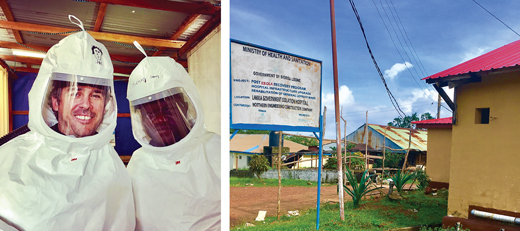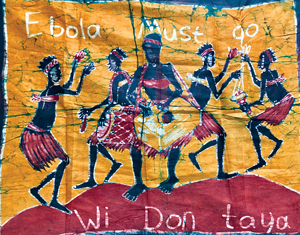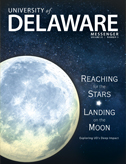Science and service
in Sierra Leone

ALUMNI | It’s the stuff of movies—scientists in white suits, protective gloves and air purifying masks working with high-risk organisms inside an ultra-mobile laboratory that resembles a trailer found on the back of an 18-wheeler. There, blood and other clinical samples are transferred through metal chambers with doors on either side, with laboratory technicians (always two at a time) working in cramped quarters barely 10 feet wide, surrounded by ventilation hoods, scientific instruments, refrigerators, freezers, computers and other high-tech gadgets.
But it’s not fiction. For six weeks last summer, it was life for Joe Russell, EOE15PhD, who worked in just such a mobile BioSafety Level 3 (BSL-3) containment facility in Sierra Leone, Africa, handling potentially infectious materials and training local Ministry of Health employees in the diagnostic techniques that help detect viral hemorrhagic fevers.
As the name suggests, hemorrhagic fevers are viruses that begin with flu-like symptoms but can quickly escalate to the bleeding disorders associated with serious diseases like Ebola, Lassa fever, Rift Valley fever or dengue.
These fevers are an ever-present public health concern throughout West Africa due to a combination of effects from the tropical environment, cramped urban living conditions and the presence of standing water during rainy season, with the elderly, children and malnourished populations considered most at-risk.
Between 2014-16, the World Health Organization reported more than 28,000 cases of Ebola in West Africa, with over 11,000 deaths, mainly in Sierra Leone, Guinea and Liberia. It was the largest outbreak of Ebola in history.

When the devastation finally ended in January 2016, mobile diagnostic laboratories installed throughout West Africa by MRIGlobal, a research nonprofit and Russell’s employer, were repurposed as training facilities to help local nationals build medical capacity and proactively monitor for potential outbreaks.
In Sierra Leone, Russell trained two Ministry of Health individuals to perform a fast, low-cost molecular biology technique known as quantitative reverse transcription polymerase chain reaction (RT-qPCR) that copies small segments of RNA to identify virus gene fragments, in this case for Ebola.
RT-qPCR is the front line in detection for disease monitoring: If the test is positive, the sample may be sent for DNA sequencing to determine whether the virus strain is known, where it may have originated and how it may be spreading.
As each sample is tied to a real person with a real symptom, RT-qPCR is a critical link in the chain for tracking outbreaks as they move. Positive results are relayed to clinicians at the patient’s hospital, which can be located just down the street, or many hours away over difficult, unreliable roads.
“Ultimately, we are looking to use technologies that provide effective surveillance and diagnosis but are not dependent on proximity to a brick-and-mortar clinic,” says Russell.
As Russell admits himself, he is a scientist, not a teacher. But in science he sees a way to benefit society, and in Sierra Leone, he saw an opportunity to serve. For instance, although the two Ministry of Health employees he trained had both worked in clinics throughout Africa, neither had a background in molecular diagnostics. That’s where Russell knew he could be of value.
His first week involved training students on typical laboratory processes and understanding the requirements of working in a BSL-3 containment facility. Once the students mastered basic tasks like accurately transferring fixed amounts of liquids and documenting samples so they can be tracked, Russell moved on to more rigorous molecular techniques, starting with RNA extraction and then RT-qPCR.
Having the students grasp the science behind each individual step, though, was an important goal.
“Working in close quarters with bulky protective gear and strict safety procedures adds a level of stress even experts struggle with,” says Russell, who earned his UD doctoral degree in marine biosciences, with a concentration in geomicrobiology, in 2015. “It can be easy to skip a step, or cut a corner, if you do not understand the science of why the material you are working with is dangerous, or how all the steps are required to achieve a reliable result. It was a culture change to help them understand, ‘Hey, I need to do this to protect myself and others.’”
While the training focused on the diagnosis of hemorrhagic fevers, the principles could easily be applied to diagnosing other prevalent pathogens in the region, like malaria and cholera.
It may seem like a departure from his doctoral student days, to go from studying how microbes interact with the Earth (geomicrobiology) to tackling world health problems like Ebola. But according to Russell, it’s not a hard lift.
“The ongoing revolution in genomics-based biotechnology has given a commonality to researchers from all different backgrounds. It’s now possible to be trained in a field like geomicrobiology and, with minimal growing pains, apply the same tools and skill-sets to a problem like infectious disease outbreaks,” he says. “The interdisciplinary training that I received at UD made me ready for that change as I entered the job market.”
Article by Karen Roberts, AS90




